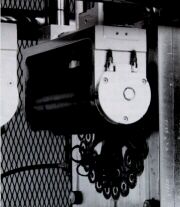Don't see what you are looking for? Many other
products available. Please use our
quickquote form to inquire.
Quad Rings
Overview
Quad Ring Seals
Rotary/Oil
Non-Rotary
Quad P.E. Plus Plastic Extrusion Seals
Quad Brand O-Rings

Standard Size Guide for Quad Ring & Quad Brand SealsThe simple o-ring is usually the designer's first choice when a sealing
application is encountered. Properly engineered to the application, an
o-ring will provide long-term performance in a variety of seal
applications. O-rings are well suited for use as static and reciprocal
seals; they are also appropriate as rotary and oscillating seals in low
speed and low pressure applications.
|

|
The o-ring is a good general purpose seal in both air and gas systems, as
well as in hydraulic applications. Air and gas system designs must include
adequate lubrication of the o-ring in order to prevent damage to the sealing
surface.
The popular o-ring cross-section is configured in a variety of
shapes as a stand alone seal, or incorporated into other rubber sealing
components such as gaskets and diaphragms. O-ring cross-sections are molded or
bonded to metal or plastic parts such as valve stems, quick-disconnect poppets
and spool valve cylinders.
|
 |
O-Ring Groove
Design
When specifying an o-ring, choose
the largest cross-section possible. The greater the cross-section, the
more effective the seal and the longer the service life. A small
cross-section does not provide the surface contact area required for an
effective seal, especially in dynamic sealing situations.
Backup
Washers
A backup washer should generally be
used at pressures greater than 1500 PSI (103.4 Bar) to prevent seal
extrusion. Groove dimensions also need to be increased to accommodate the
added thickness of the washer. |
|
|
|
Groove Design for O-Rings
Without Backup Washers
All surfaces and corners must be free of tool marks, nicks or
scratches.
- Refer to
Clearance Chartto
determine proper diametrical clearance based on the pressure encountered
and the hardness of the rubber compound.
- Bore Diameter "A" (at upper limit), minus two times Groove Depth
"C", equals Piston Groove Diameter "B."
A - (2 x C) =
B
Rod Diameter "H" (at lower limit), plus two times Groove
Depth "C", equals Groove Diameter "L."
H + (2 x C) =
L
- For backup washers, increase groove length "D" by thickness of
washers used. Use minimum radius in groove.
NOTE:
See Non-Rotary section for
additional groove design information. |
|
Recommended Starting Dimensions
for Typical O-Ring Applications
| Seal
Number |
Actual
Cross-
Section |
Minimum C/S
Squeeze |
Maximum "C" for
Minimum
C/S Squeeze |
Groove "D"
Axial
Dimen.
-.000/+.005 in.
(-.000/+.127mm) |
| |
(in) |
(mm) |
Dynamic
Static1
(in) |
Dynamic
Static2
(mm) |
Dynamic
(in) |
Static
(in) |
Dynamic
(mm) |
Static
(mm) |
(in) |
(mm) |
| 8004-8050 |
.070 ± .003 |
1.780 ± .076 |
.010 .015 |
.254 .381 |
.055/.057 |
.050/.052 |
1.397/1.448 |
1.270/1.320 |
.094 |
2.387 |
| 8102-8178 |
.103 ± .003 |
2.616 ± .076 |
.010 .017 |
.254 .432 |
.088/.090 |
.081/.083 |
2.235/2.286 |
2.057/2.108 |
.141 |
3.581 |
| 8201-8284 |
.139 ± .004 |
3.530 ± .101 |
.012 .022 |
.305 .559 |
.121/.123 |
.111/.113 |
3.073/3.124 |
2.819/2.870 |
.188 |
4.775 |
| 8309-8395 |
.210 ± .005 |
5.334 ± .127 |
.017 .032 |
.432 .813 |
.186/.188 |
.171/.173 |
4.724/4.775 |
4.343/4.394 |
.281 |
7.137 |
| 8425-8475 |
.275 ± .006 |
6.985 ± .152 |
.029 .049 |
.736 1.244 |
.238/.240 |
.218/.220 |
6.045/6.096 |
5.537/5.588 |
.375 |
9.525 |
|
|
|
|
See chart for Quad-Ring seal groove dimensions.
- In certain cases (e.g., very close control of concentricities, absence of
temperature extremes, etc.) tests may indicate that the squeeze can be reduced
(and seal life prolonged) by increasing the groove diameter.
- For certain shaft sizes, use of the standard size Series 4 seal may
require more peripheral squeeze than is desired for the application. In such
cases, use of a special size Series 4 seal is recommended. Contact our Fluid
Delivery Team for details.
|
Information Provided by Minnesota Rubber/Quadion Corporation, copyright
2002
Product names are
Registered trademarks of Minnesota Rubber, A Quadion Company.
|
